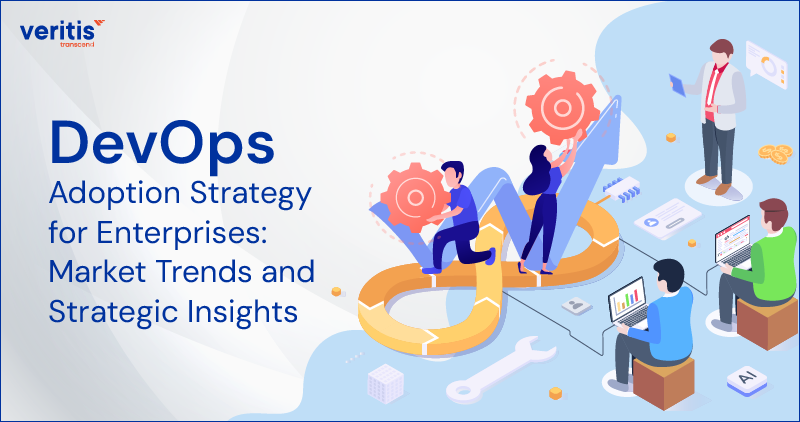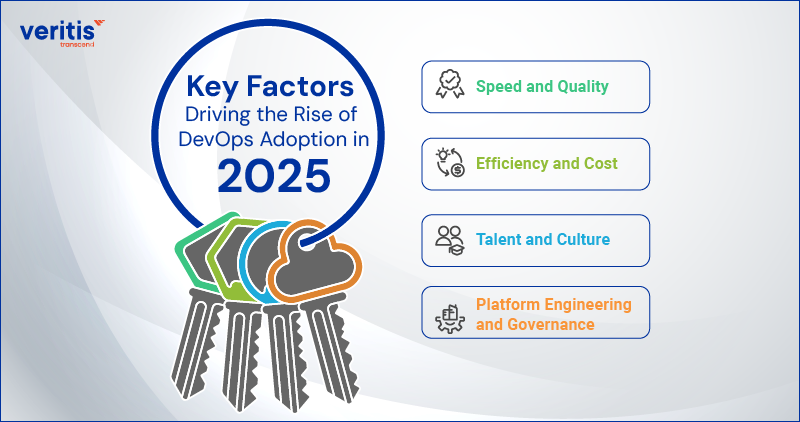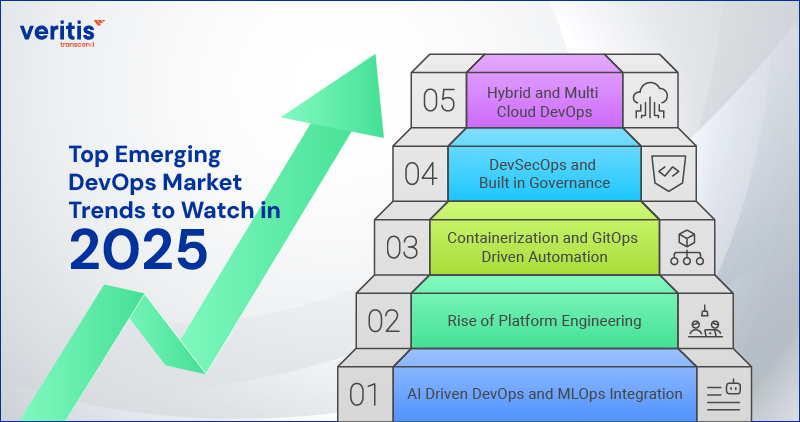
Rising consumer expectations and the demand for intelligent, seamless digital experiences have accelerated the pace of change in the IT industry. As a result, organizations across every sector are under pressure to adopt the right technology strategies that deliver a competitive edge.
Among the many approaches explored, one transformative practice stands out: DevOps.
More than a set of tools or processes, DevOps adoption represents a cultural shift that redefines how development (Dev) and operations (Ops) teams collaborate. Organizations that adopt DevOps benefit from faster delivery cycles, improved system reliability, and continuous innovation, all while maintaining a cohesive, cross functional work environment.
With the right DevOps strategy and expert guidance, companies can completely leverage the potential of this approach. Today, the adoption of DevOps has become a critical enabler for achieving continuous delivery, faster incident recovery, and scalable product innovation.
In the current market, speed, quality, and collaboration are non negotiable. That’s why 83% of IT decision makers report adopting DevOps to generate greater business value, while 99% say that DevOps has had a positive impact on their organization. DevOps has transcended its buzzword status; it’s now a crucial part of culture. With the proper guidance and expertise, DevOps consulting services have become essential for organizations to fully realize the potential of this culture.
Crafting a Modern DevOps Adoption Strategy for 2025
Successfully embracing DevOps requires more than just implementing new tools, it demands a structured, culture driven approach. A well defined DevOps adoption strategy helps organizations evolve from disconnected, inefficient processes to a high performing, unified delivery model.
Here’s a modern, four phase strategy to adopt DevOps effectively in 2025:
1) Assess and Align
Begin by evaluating your existing IT landscape, identifying silos, and aligning the goals of development, operations, and the business. Build executive sponsorship, clarify ownership, and define the metrics that will guide your DevOps strategy.
2) Modernize and Integrate
Introduce Agile practices, CI/CD pipelines, and version control systems. Break down silos by integrating toolchains and workflows. The goal at this stage is to standardize environments and enable collaboration through shared responsibility.
3) Automate and Accelerate
Drive efficiency with infrastructure as code, test automation, and continuous deployment. Automation is the foundation for scalability and reliability, two essential outcomes of any successful DevOps adoption initiative.
4) Monitor, Measure, and Evolve
Build observability into every layer, from code to infrastructure to user experience. Real time monitoring, feedback loops, and analytics help improve system resilience and support continuous improvement.
Key Factors Driving the Rise of DevOps Adoption in 2025

The decision to adopt DevOps is a strategic move delivering measurable business value across speed, quality, cost, and culture. Below are the core drivers accelerating the global adoption of DevOps and shaping enterprise wide transformation:
1) Speed to Market and Quality Gains
A significant reason organizations pursue DevOps adoption is the need to innovate faster. Nearly 50% of companies report reduced time to market after implementing a modern DevOps strategy, while 61% see improved product quality and reduced deployment failures. (Sources: arXiv, Gartner, Spacelift)
2) Operational Efficiency and Cost Optimization
Organizations that adopt DevOps frameworks gain agility and reduce overhead. DevOps driven teams reclaim 33% more time for innovation, while infrastructure costs drop by as much as 30% thanks to automation and optimized resource allocation. (Sources: DevOpsBay, Spacelift)
3) Talent Retention and Culture Transformation
Rather than hiring new teams, companies that invest in a strong DevOps strategy often upskill their existing employees. This boosts retention, enhances team morale, and fosters a high performing, cross functional culture, a crucial factor in the sustainable adoption of DevOps.
4) Platform Engineering and Governance
Over 94% of enterprises now recognize platform engineering as vital to fully unlocking the benefits of DevOps adoption. Internal developer platforms (IDPs) centralize tooling and standardize practices, while governance frameworks ensure compliance, scalability, and security without sacrificing agility. (Sources: Gartner, Baytech Consulting, Wikipedia)
How DevOps Adoption is Driving Market Growth in 2025
As digital transformation accelerates, the adoption of DevOps continues to gain momentum across industries. Organizations are no longer asking whether they should adopt DevOps, but rather how quickly they can scale their DevOps strategy to meet business demands.
1) Global DevOps Adoption
Recent industry reports confirm that 80–81% of organizations have now implemented DevOps in some capacity. Notably, 50% of those adopters are categorized as high performers, demonstrating faster release cycles, higher system stability, and stronger innovation capacity. (Sources: Gartner, Baytech Consulting)
2) Market Size and Projected Growth
The DevOps market worldwide is anticipated to expand to USD 12.2 billion by 2026, experiencing a vigorous annual growth rate of 19%. This momentum stems from the growing requirement for widespread DevOps implementation and the enhancement of both application deployment and infrastructure automation processes. (Sources: Statista, Grand View Research)
3) Platform Centric DevOps Strategy
A significant evolution in DevOps adoption strategy is the move toward unified DevOps platforms. According to Gartner, by 2027, nearly 80% of enterprises will standardize on consolidated toolchains, up from just 25% in 2023. This shift streamlines governance, security, and automation through cohesive platform engineering. (Sources: Gartner, Getint.io)
Top Emerging DevOps Market Trends to Watch in 2025

As organizations refine their DevOps strategy to keep pace with innovation, several emerging trends are shaping how they adopt DevOps at scale. These shifts are not technological; they’re foundational to sustaining high performance software delivery in 2025 and beyond.
1) AI Driven DevOps and MLOps Integration
AI is evolving into a key pillar of modern DevOps adoption. From predictive incident detection to self healing infrastructure, AI is automating complex decision making across the pipeline. The integration of DevOps with MLOps is also becoming increasingly essential, ensuring that machine learning models transition seamlessly from development to production within the DevOps lifecycle.
2) Rise of Platform Engineering
Platform engineering is redefining how organizations adopt DevOps by creating internal developer platforms (IDPs) that offer standardized, self service environments. These platforms combine CI/CD, Infrastructure as Code (IaC), observability, and security, supporting a scalable and repeatable DevOps strategy across teams.
3) Containerization and GitOps Driven Automation
As DevOps adoption matures, containerized architectures and GitOps practices are becoming standard. GitOps enables declarative deployments and automated rollbacks using Git as the single source of truth. Combined with containers and IaC, it ensures scalable, secure, and repeatable delivery pipelines.
4) DevSecOps and Built In Governance
Security is no longer an afterthought in the DevOps strategy. DevSecOps embeds security across the software delivery lifecycle, from code to production, through continuous compliance checks, automated vulnerability scanning, and policy driven guardrails. This makes secure DevOps adoption not only achievable but scalable.
5) Hybrid and Multi Cloud DevOps
Modern DevOps adoption is increasingly spanning hybrid and multi cloud environments. To maintain consistency across platforms like AWS, Azure, and on-prem, organizations are evolving their DevOps strategy with cloud agnostic tools, IaC, and centralized pipelines. This flexibility is key to adopting DevOps at scale in complex infrastructures.
Best DevOps Practices to Adopt in 2025
A successful DevOps adoption requires more than tools; it demands a mindset shift and a scalable strategy. The best practices to help organizations adopt DevOps effectively and sustain long term value:
1) Start with Culture
Prioritize shared ownership, transparency, and collaboration across development, operations, and business teams to drive effective outcomes. A strong cultural foundation is important for driving a resilient DevOps strategy.
2) Standardize with DevOps Platforms
Streamline workflows by integrating CI/CD pipelines, observability tools, and automation into a single platform. This reduces tool sprawl and creates consistency, enabling faster and more reliable DevOps adoption.
3) Integrate AI and Intelligent Automation
AI powered pipelines accelerate incident detection, triage, and resolution, boosting performance across the delivery lifecycle. Make AI a core part of your evolving DevOps strategy.
4) Expand DevOps to MLOps
For AI/ML driven teams, adopt DevOps practices that treat ML models as deployable and testable assets within CI/CD workflows. This ensures model reproducibility, traceability, and production readiness.
5) Embed Security and Governance
Build security into every stage of your pipeline with DevSecOps. From policy enforcement to automated compliance checks, robust governance strengthens the integrity of your DevOps adoption.
Real-World Insight: Aligning with DevOps Market Trends
Veritis helped an analytics provider accelerate product development by implementing a streamlined DevOps strategy. This transformation reflects the broader market shift toward faster, more reliable software delivery through DevOps.
To see how Veritis aligns strategy with evolving market demands across industries, explore another success story: DevOps Adoption Strategy and Market Trends
In Conclusion
While factors such as deployment automation (66 percent), version control (62 percent), continuous integration (59 percent), and infrastructure automation (57 percent) are the most common starting points for the DevOps journey, aspects such as working in small batches to allow single-piece flow, visualization of important quality and productivity metrics, and setting limits on work in progress are the least common starting points.
Overall, DevOps services and solutions are no longer just a buzzword! They have become a culture and an integral part of many organizations as a means to improve overall performance, profitability, revenues, and various other key metrics, yielding remarkable results.”
This version smoothly integrates the keyword while keeping the overall message intact. Let me know if you’d like to tweak anything further!
Also Read: